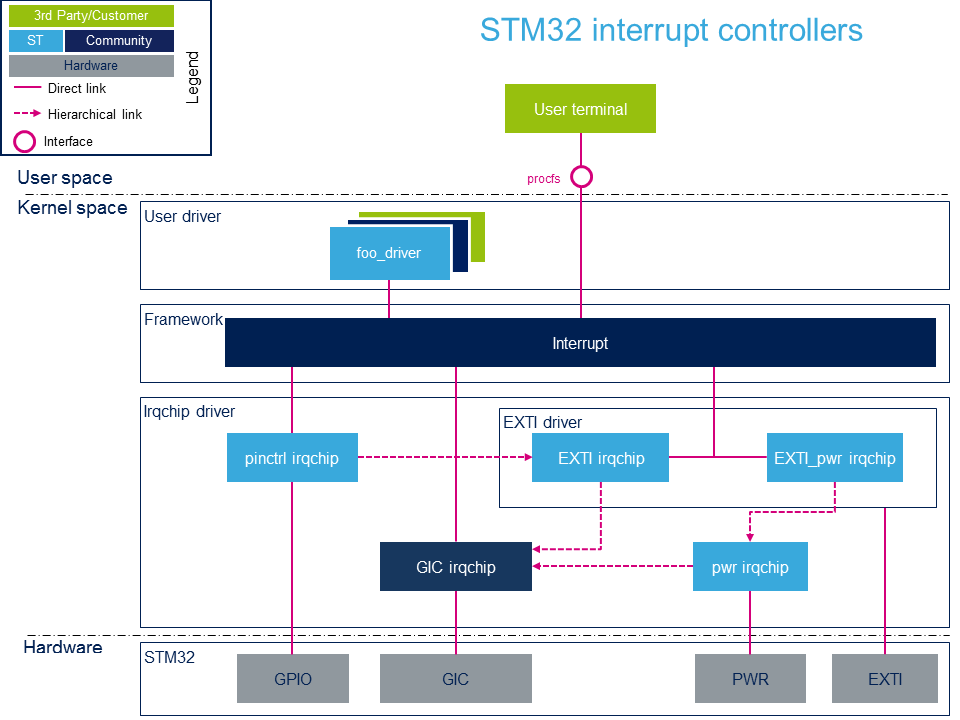This article explains stm32mp157 interrupt topology and its management on Linux® environment.
1. Framework purpose[edit source]
The Linux® kernel software layer that handles the interrupts is splitted into two parts:"
- A generic part:
- providing a common API to request and configure an interrupt line.
- creating a virtual mapping for all interrupts in order to have only one ID per interrupt.
- providing callback for irqchip registering.
- An irqchip driver part:
- handling hardware accesses and managing specific features.
For more information refer to Linux® kernel documentation in core-api/genericirq.html[1].
2. STM32 interrupt topology[edit source]
As explain in Framework purpose, the irqchip driver makes the interface with the hardware to configure and manage an interrupt. On STM32MP1 devices, a hardware interrupt can be generated by GIC, EXTI, PWR or GPIO. Several irqchip drivers are consequently required, one per hardware block.
The next section provides topology information for each kind of interrupt source.
2.1. Overview[edit source]
2.2. Component description[edit source]
- procfs: provides interrupt information to the user space.
- foo_driver: device driver requesting an interrupt line.
- interrupt framework: generic part described in the Framework purpose section.
- Irqchips:
- GIC irqchip: GIC irqchip driver part. This irqchip driver is used when a GIC interrupt is directly requested by a device. This is the case for all the peripheral interrupts that are not wakeup sources. This irqchip is in charge of controlling the GIC internal peripheral (hardware). An example of GIG irqchip usage is available here.
- EXTI irqchip: EXTI irqchip driver part. This irqchip driver is used when an EXTI interrupt (EXTernal Interrupt) is requested by a device. This kind of interrupts is used to wake up the system from low-power mode. This irqchip directly controls the EXTI internal peripheral but it is also linked to the gic irqchip through the hierarchical irq domain mechanism[2]. This link is transparent for the requester.
- EXTI_pwr irqchip: EXTI_pwr irqchip driver part. This irqchip driver is used when an EXTI interrupt mapped to a wakeup pin is requested by a device. This kind of interrupts is used to wake up the system from the deepest low-power mode (more details about low-power modes are available here). This irqchip directly controls the EXTI internal peripheral but it is also linked to the pwr irqchip through the hierarchical irq domain mechanism[2]. The pwr irqchip in turn controls the PWR internal peripheral and it is also linked to the gic irqchip through the same hierarchical irq domain mechanism[2]. These hierarchical links are transparent for the requester.
- Pinctrl irqchip: Pinctrl irqchip driver part. This irqchip driver is used when a device wants to configure/request a GPIO as an interrupt. It directly controls the GPIO internal peripheral but it is also linked to the EXTI irqchip through the hierarchical irq domain mechanism[2]. This link is transparent for the requester.
- STM32 hardware peripherals: GIC, EXTI, PWR, GPIO
3. API description[edit source]
The kernel space API is the interface for declaring and managing interrupts. The user space interface is used to monitor interrupt information or set interrupt affinity.
3.1. User space API[edit source]
procfs performs the following tasks:
- It provides information about interrupts such as the virtual number, the hardware ID and the irqchip used (see chapter 1.2 Kernel data of /proc kernel documentation[3]).
root@stm32mp1:~# cat /proc/interrupts CPU0 CPU1 17: 0 0 GIC-0 37 Level rcc irq 20: 7509664 7509640 GIC-0 27 Level arch_timer 22: 0 0 GIC-0 232 Level arm-pmu 23: 0 0 GIC-0 233 Level arm-pmu 24: 0 0 GIC-0 68 Level 4000b000.audio-controller 26: 0 0 stm32-exti-h 27 Edge 4000e000.serial:wakeup 27: 8915 0 GIC-0 84 Level 40010000.serial 28: 0 0 stm32-exti-h 30 Edge 40010000.serial:wakeup 29: 654 0 GIC-0 63 Level 40012000.i2c 30: 0 0 GIC-0 64 Level 40012000.i2c 31: 0 0 stm32-exti-h 21 Edge 40012000.i2c:wakeup 33: 0 0 GIC-0 123 Level 4400b004.audio-controller, 4400b024.audio-controller ...
- It configures interrupt affinity[4], that is assigns an interrupt to a dedicated CPU.
3.2. Kernel space API[edit source]
The main kernel API drivers for users are the following:
- devm_request_irq: requests an interrupt.
- devm_free_irq: frees an interrupt.
- enable_irq: enables a requested interrupt.
- disable_irq: disables a requested interrupt.
- enable_irq_wake: enables a requested interrupt that could wake up the system.
- disable_irq_wake: disables a requested interrupt that could wake up the system.
... The available routines can be found in Linux® kernel header file: include/linux/interrupt.h[5].
4. Configuration[edit source]
4.1. Kernel configuration[edit source]
The interrupt framework and irqchip drivers are enabled by default.
4.2. Device tree configuration[edit source]
The generic way to declare an interrupt in the device tree is declared in Linux® kernel documentation in: Documentation/devicetree/bindings/interrupt-controller/interrupts.txt [6].
However each irqchip driver has his own bindings description. The below chapters provide the link to the bindings documentation for each interrupt controller as well as a simple example of interrupt declaration.
4.2.1. GIC irqchip[edit source]
- Documentation/devicetree/bindings/interrupt-controller/arm,gic.txt [7]
- Device tree usage:
&foo_node { ... interrupts = <&intc GIC_SPI 72 IRQ_TYPE_LEVEL_HIGH>; interrupt-names = "foo_name"; ... };
4.2.2. EXTI irqchip[edit source]
- Documentation/devicetree/bindings/interrupt-controller/st,stm32-exti.txt [8]
- Device tree usage:
&foo_node {
...
interrupts-extended = <&exti 26 IRQ_TYPE_EDGE_RISING>;
interrupt-names = "foo_name";
...
};
4.2.3. EXTI_PWR irqchip[edit source]
- Documentation/devicetree/bindings/interrupt-controller/st,stm32-exti.txt [8]
- Device tree usage:
&foo_node {
...
interrupts-extended = <&exti_pwr 55 IRQ_TYPE_EDGE_FALLING>;
interrupt-names = "foo_name";
...
};
4.2.4. pinctrl irqchip[edit source]
- Device tree usage:
&foo_node {
...
interrupts-extended = <&gpioa 14 IRQ_TYPE_EDGE_FALLING>;
interrupt-names = "foo_name";
...
};
4.2.5. pwr irqchip[edit source]
Pwr irqchip has not to be used directly. User has to use exti_pwr to invoke pwr irqchip thanks to the hierarchical implementation.
5. References[edit source]
- ↑ Generic IRQ documentation
- ↑ Jump up to: 2.0 2.1 2.2 2.3 https://www.kernel.org/doc/Documentation/IRQ-domain.txt(master), IRQ domain documentation
- ↑ https://www.kernel.org/doc/Documentation/filesystems/proc.txt(master), User space /proc documentation
- ↑ https://www.kernel.org/doc/Documentation/IRQ-affinity.txt(master), IRQ affinity documentation
- ↑ [include/linux/interrupt.h ], Kernel interrupt API
- ↑ Generic interrupts bindings documentation, Generic interrupts bindings documentation
- ↑ https://www.kernel.org/doc/Documentation/devicetree/bindings/interrupt-controller/arm,gic.txt(master), GIC controller binding documentation
- ↑ Jump up to: 8.0 8.1 https://www.kernel.org/doc/Documentation/devicetree/bindings/interrupt-controller/st,stm32-exti.txt(master), Exti interrupts bindings documentation
